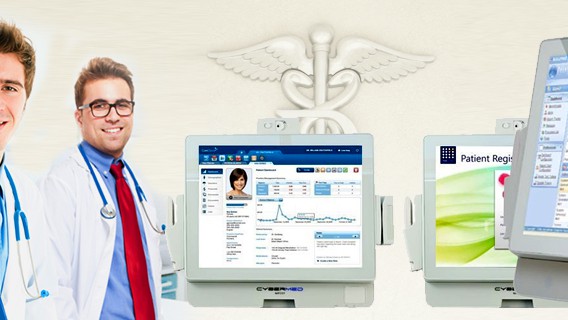Every organization consists of different departments working in sync together to move forward. This is doubly true with healthcare organizations such as hospitals, which measure success in lives saved and patients healed rather than profit and loss. A given hospital’s medical-grade computers need to work in conjunction with the organization’s entire network, which can include not just other computers but legacy medical devices integral to patient care. Most administrators can tell you what a challenge that is.
Interoperability – the ability of medical PCs to work harmoniously across a network with each other – can streamline the healthcare process, make paperwork easier and ensure that timely data gets into the right hands at the right time. The kind of medical computer your organization uses can make a huge difference on that front, turning what could be a patchwork of different units and operating systems into a smoothly running whole.
Go in Stages
Most healthcare organizations are quite large and require numerous medical computers in order to function. When the time comes to replace them, it usually takes place in stages. Annual budgets don’t normally allow for more than a percentage of a given organization’s systems to be replaced at any one time, and upgrades are usually staggered to minimize the impact of a big change.
This can make interoperability very difficult, with different makes and models of medical PCs utilizing different operating systems, all trying to function as part of the same network. A recent report by Healthcare Informatics states that an average of 15 percent of all hospital computer systems run on outdated operating systems. That can cause huge interoperability problems. Outdated systems may struggle with electronic medical records (EMR), for instance, and require elaborate workarounds in order to function.
With that in mind, it makes sense to look for medical computers with a long life cycle: ideally 3-5 years. That ensures that the computers you purchase a few years ago will still operate the same way the computers you’re preparing to install this year, which enhances their interoperability and allows EMRs and other vital software to function smoothly across your entire network. That permits your organization to upgrade computers more gradually without having to integrate different hardware and software.
Integrate at the Point of Care
Interoperability functions most effectively when it is integrated at the point of care: where doctors, nurses and other healthcare professionals directly treat the patients. The ability to document the patients’ treatment as it is delivered – including vital signs, medication and overall progress of healing – can drastically reduce the frequency of errors and ensure that all of the data is accurate.
Furthermore, information integrated into the system at point-of-care allows for much faster response times, allowing specialists and other medical personnel to evaluate the quality of treatment and plan for further care. In the event of a problem – say, a drop in the patient’s blood pressure – then those plans can be altered or revised to reflect the current data.
For example, Acute Care Testing cites a report on emergency services that saw a 2.5% mortality rate for patients boarded less than two hours slowly climb to a 4.5% mortality rate for patients boarded for 12 hours or longer. Compare that information to a study by the U.S. Department of Health, which found that point-of-care treatment — properly cataloged and integrated into an existing network — provides actionable data an average of 46 minutes sooner than lab tests or other factors. Smooth integration of such data allows care to be received that much sooner and reduces the frequency of mortality rates among patients. It can quite literally save lives.
Medical PCs, particularly mobile PCs like medical cart computers, can further facilitate this by using barcode scanners and radio frequency IDs (RFID) to scan and log patient data instantly from wristband IDs, medication containers and the like. They can gather needed data with just a swipe, then log the information and allow hospital staff to act on it when time is of the essence.
Don’t Forget Legacy Devices
Legacy devices – outdated technology that still sees regular use – can be one of the biggest challenges to interoperability. Such devices may not be compatible with modern software, and yet the data they provide can be invaluable to effective care. The American Hospital Association estimates that most medical organizations can only afford to replace 10% of their legacy devices per year, meaning that methods must be found to integrate functioning devices to the larger network as a matter of simple financial necessity.
Medical-grade computers can address this by providing an access point for the legacy device. Legacy ports such as RS-232 serial ports allow you to connect the computer to the legacy device, which not only improves its functionality but can better integrate the information it delivers into the network’s larger database. Not only does that enhance the functionality of legacy devices, but it can cut down on the time required to log the data they provide: ensuring that the medical organization can maximize their utility for as long as possible.
Cybernet Manufacturing offers a variety of medical-grade PCs that can help you address the challenges of interoperability. Call on us today to discuss your options!
How Medical Grade Computers Improve the Standard of Care in the Medical Profession
August 3, 2015
The face of the healthcare industry has changed drastically in the past decade. Now, the use of devices like medical grade computers in patient rooms, emergency rooms, and operating rooms have allowed healthcare service…
0 Comments6 Minutes
4 Medical Devices that Absolutely Need Integrated Medical Computers
April 9, 2019
The days of enormous computers and huge medical devices are nearly over — as technology advances, it shrinks, and in no field is that more useful than in healthcare. Smaller tech means more mobile and agile medical…
0 Comments8 Minutes
You Can't
Learn from a Pop-up
But we can deliver knowledge to your inbox!
We dive deep in the industry looking for new trends, technology, news, and updates. We're happy to share them with you.
Knowledge, News, and Industry Updates Right in Your Inbox




